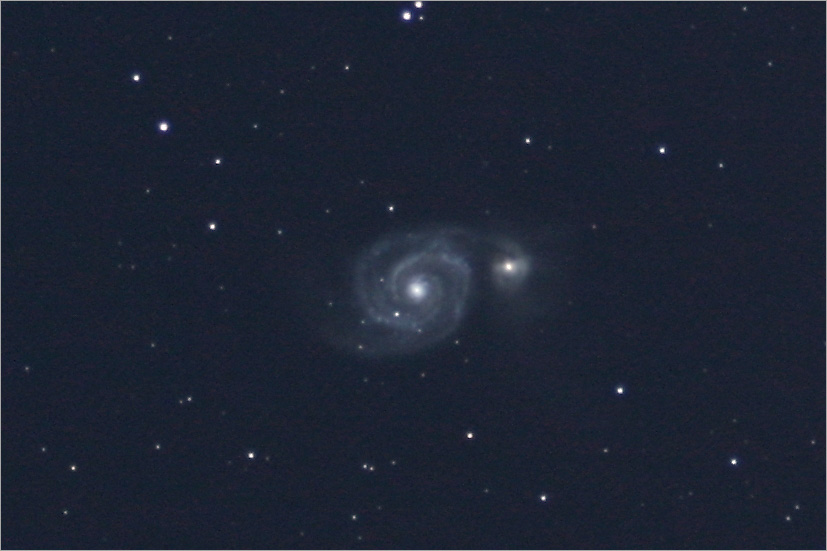|
Wonders in the Sky
|
M51, The Whirlpool Galaxy
|
Back |
Up |
Next
|

Stacked and Tracked
M51, The Whirlpool Galaxy
This image shows the results from shooting multiple originals and stacking them. Stacking smooths the background and improves the signal-to-noise ratio in the image.
Multiple originals are also easy to shoot because you are already set up and focused on the object.
It's a good idea to shoot multiple originals anyway, because you will loose some to tracking errors. If you just shoot one frame and don't look at it at high magnification until you get home, you have a pretty good chance that something will be wrong with the frame, either focus or tracking, and you will have to throw it away.
|
|
M51 is a wonderful bright face-on spiral galaxy located about 31 million light years away from us in the constellation of Canes Venatici.
It was one of the first discoveries made by Charles Messier in 1773, and it was the first galaxy where spiral structure was observed, by Lord Rosse in 1845.
M51 has an apparent size of about 6 x 10 arc minutes and shines at magnitude 9. It has an estimated mass of 160 billion suns.
A faint companion galaxy, NGC 5195, seen here to the right of M51, is interacting with M51. NGC 5195 shines at 9.6 magnitude and is about 5 arc minutes in diameter.
Image Data
- Lens / Scope: Stellarvue SV70ED ED doublet refractor
- Focal Length: 420mm
- F/stop: f/6
- Exposure: Stack of eleven 3-minute exposures (33 minutes total exposure)
- Mount: Orion Sirius polar-aligned German-equatorial mount
- Guiding: None
- Camera: Unmodified Canon EOS 1000D (Digital Rebel XS)
- Mode: JPEG
- ISO: 1600
- White Balance: Custom, set on sky background
- In-Camera Noise Reduction: Off
- Filter: None
- Temp: 62F
- Start Time: 11:36 p.m.
- Date: May 21, 2009
- Location: Maxwell, NJ
- Calibration: None
- Processing: Standard in-camera JPEG processing. Stacked in DeepSky Stacker.
|